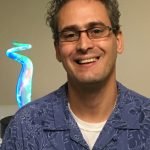Darrell S.C.S. Misak, ND, RPh
In last month’s article (Part 1), I introduced Bio-Electric Chemistry and explained how all matter is energy and is represented as variable frequencies, like waves of the ocean rolling off one another. I introduced the genius work of Dr Carey Reams (Figure 1) who mathematically explained human biology in terms of energy and frequency, and identified the ideal chemistry equation to maximize energy efficiency in the human body. Part 2 of this introduction elucidates what is needed to do the simple in-office testing of urine and saliva, along with a basic understanding of how that information can help you understand client symptomology, guide therapy direction, and predict healing responses.
Why guess when you can know?
(Carey Reams)

Equipment & Measurements
Analysis begins with appropriate tools. A refractometer, pH meter, conductivity meter, pen light, and an agricultural nitrates testing kit is what you need to start. I use an agricultural testing supply company in Maine, which also has resource information about Ream’s Biological Theory of Ionization (RBTI). These tools will enable you to measure the aforementioned variables and form the equation on your test subject using urine and saliva samples. Keep in mind that this is not diagnostic lab work, hence the use of this equipment does not require any office lab certification.
As a reminder, Dr Reams determined an energy equation for the line of least resistance of energy in humans, which can be measured using urine and saliva:
1.5brix 6.4urine pH/6.4saliva pH 6.5C (conductivity) 0.04M(cell debris) 3(nitrate nitrates)/3(ammonia nitrates) + CS (common sense)
When you record your measured values, always record them in the same order as the above equation, along with your client’s age, sex, height, weight, occupation, and time that the sample was collected; doing this will enable you over time to understand the effects this data has on the client’s energy patterns. I also do simple urine dipstick tests of vitamin C saturation, as well as a Multistix 10 for added understanding of metabolic patterns and kidney stress; however, this article will only focus on Ream’s analysis and an introduction to these concepts.
Interpretation
The equation variables represent the balance and efficiency of how the body moves energy in and out in an attempt to maintain and optimize homeostasis. The “brix” value of the urine, as measured by a refractometer, primarily represents sugars and potential or available energy. A refractometer measures the total dissolved solids in a solution; Reams showed that in urine this is primarily sugars and salt when conductivity exceeds a value of 15. Urine pH represents post-digestive efficiency, and saliva pH represents pre-digestive efficiency (ie, how energy can move through the system), as well as helping to locate a Y-axis body site of energy loss.
Reams showed that pH is a measure of friction, or “resistance,” and that a pH of 6.4 is the neutral electrical point where ions can change in spin direction to be either cationic or anionic, depending on external influences. Conductivity of the urine represents the ability of energy to move through the system; a conductivity of 6.5 (6.5C) represents the ideal value where electrical flow can freely move throughout the body; conductivity that is too high or too low affects the ability of energy to get where it is needed.
Urine cell debris is the next equation value, which represents kidney stress along with cell turnover and elimination efficiency of useless cellular waste. Finally, the nitrate nitrates and ammonia nitrates represent ureas, which provide insight into detoxification or elimination potential, potassium and magnesium needs, pancreatic enzyme production potential, an X-axis body location of energy loss, the ability to build new cells, and the degree of electro-magnetism of the system.
These descriptions are simplified to provide a general understanding; however, with practice and deeper understanding, a functional explanation of what the body is doing and where your point(s) of weakness lie become evident, and thus supportive needs become obvious. When you consider the Brix, pH, and Conductivity to represent potential energy, efficiency, and resistance of energy movement into the system, and the Conductivity, Cell Debris, and Nitrates to represent how energy moves out of the system, the variables tell a story of energy balance and efficiency.
Illness starts when you continue to burn up more energy than you take in.
(Carey Reams)
Forming A Picture of Health
To elucidate further on each variable, their inter-relations, and associated physical symptoms helps create a “picture” of health. Keeping in mind that you must gain more energy than you consume, improvements in sugar regulation (ie, brix control), calcium, and mineral utilization (ie, pH regulation), and salt /protein regulation (ie, conductivity monitoring) becomes equivalent to stimulation or regulation of the vital force, in naturopathic terms.
You must also keep in mind that with efficiency and metabolism stimulation, there must also be a detoxification of the waste byproducts. This is where you must learn to understand and recognize the bio-electric ability to handle detox by observing how efficiently the body eliminates excess minerals, protein, and salt (ie, conductivity monitoring), kidney stress and efficiency of cell-waste elimination (ie, cell debris observations), and protein breakdown vs cell building ability with enough energy to process the waste (ie, nitrate monitoring). As you recognize and understand the detoxification reactions, you can begin to predict certain symptoms associated with detox, based on the particular clients’ chemistry patterns, as well as recognize when therapies (eg, far-infrared sauna, colonics, hydrotherapy) are needed to aid and support the process. Symptom patterns are associated with each measurable variable that is away from ideal and/or a combination or pattern of several variables that are away from ideal.
Reams showed that sugar regulation parallels oxygen availability and potential energy. Oxygen is needed in all restorative processes and brix represents about 15 sugars that are eliminated through the urine; too high or too low sugars are associated with decreased oxygen availability. Symptoms of low sugars include: lightheadedness, dizziness, extreme fatigue, muscle aching, morning grogginess, “sugar crashing” between 11 AM and 2 PM, frontal headaches, migraines, seizures, forgetfulness, cold intolerance, etc. Conversely, high sugar symptoms include: mental fog, cluster headaches, muscle aches, numbness in extremities, rapid heart rates, nervousness, insomnia, need to urinate at night, hot flashes, etc.
Energy resistance, as measured by pH, shows cationic (decreased resistance/acidic) or anionic (increased resistance/alkaline) tendencies, which reflects energy efficiency and mineral utilization. Cationic symptoms include: diarrhea, non-digested food in stools, hip and lower extremity pain, premenstrual cramping and heavy menstrual flow, prostate complaints, malabsorption deficiencies, etc. Anionic symptoms include: constipation, sinus and respiratory complaints, skin eruptions, vision complaints, shoulder and upper extremity pains, thyroid issues, cluster headaches, teeth and jaw issues, etc.
While brix values represent sugars, urine conductivity represents salt and protein catabolism. Too low conductivity, and the body won’t absorb minerals from the diet, whereas too high conductivity, and the body over de-ionizes, forming crystallization of organic and inorganic salts; this can lead to hardening of arteries, oxidative damage, and breakdown of cartilage and smooth muscle. Symptoms of high conductivity include: high blood pressure, elevated cholesterol, angina, heart attack risk, arthritis and joint pain, diverticulitis, poor bladder control, etc. The cell debris variable provides insights, as mentioned, but the only symptom typically recognized with high values is water imbalances, edema, etc. Low cell debris can be worrisome when other variables are showing improved efficiency, as it represents poor elimination of inefficient cells and waste; this will be seen in the sclera, with irritated blood vessel patterns. Dr Reams taught sclera patterns and used them to predict responses to therapy.
Reams showed that all new cell formation begins with the energy created from nitrogen; nitrate monitoring, as mentioned, gives insight into many processes. Total nitrates <12 also correlate with a cellular potassium deficiency, with associated symptoms including forgetfulness, restlessness, low thyroid activity, arrhythmias, poor sleep, weakness, Raynaud’s complaints, and more. High total nitrates stimulate heart contractility (as heard by strong tones on auscultation), and can help predict angina and potential myocardial infarctions. High ammonia nitrates is consistent with protein catabolism and gives insight into kidney stress and levels of degeneration, whereas nitrate nitrates reflects protein building capacity and gives insight into pancreatic and liver enzyme capacity, compliance with a high-vegetable diet, and the need for rest. All listed symptoms and more are interdependent on the other variable measurements; again, as you learn to see the “picture” of how the variables inter-correlate and change with each other, a clear pattern of symptoms becomes predictable.
If you were told everything that could happen about these numbers and the 2600 differentials, if you read rapidly, it would take 2,000 years to read if you read 12 hours every day.
(Carey Reams)
Closing Comments
All systems have weaknesses, and RBTI’s weakness is the loss of Dr Ream’s research to explain how to calculate reserve energy accurately, know how to use the equation variables to determine the specific “frequency,” and how to determine the frequency of foods to correct the measured imbalances. Additionally, the available fasting and diet guidelines are difficult to institute in a non-retreat, center-based practice, and some of which should not be recommended unless these concepts are fully understood. The conditions in which I have seen improvements or restoration when applying these concepts are too numerous to list. This system is not a form of diagnosis, treatment, prevention, or cure, but instead is an analytical method for teaching health and observing restoration. A longer article could illuminate the many fascinating details of what bio-electric concepts in your practice can offer; however, I hope this article at least challenges each reader to test, learn, and help build upon techniques that I believe can become a standard of restorative naturopathic care that few have witnessed in practice.
The one who gets wisdom loves life; the one who cherishes understanding will soon prosper.
(Solomon; 990 BC-931 BC)
 Darrell S.C.S. Misak, ND, RPh, is a 2000 NCNM graduate, a licensed pharmacist, and a father of 5 healthy children. After receiving his BSc degree in Pharmacy in 1992, he gained 3 ½ years of university hospital pharmacy experience at Duke University Medical Center, and during his NCNM studies gained over 4 years of compounding pharmacy experience. Since moving to the Pittsburgh area, he has delivered regular lectures and hosts a bimonthly radio program, “A Natural Connection,” where he teaches the concepts of bio-electric chemistry. Dr Misak owns and operates Pittsburgh Alternative Health, Inc, where his focus is on health analysis and how to support optimal energy formation that results in natural health restoration.
Darrell S.C.S. Misak, ND, RPh, is a 2000 NCNM graduate, a licensed pharmacist, and a father of 5 healthy children. After receiving his BSc degree in Pharmacy in 1992, he gained 3 ½ years of university hospital pharmacy experience at Duke University Medical Center, and during his NCNM studies gained over 4 years of compounding pharmacy experience. Since moving to the Pittsburgh area, he has delivered regular lectures and hosts a bimonthly radio program, “A Natural Connection,” where he teaches the concepts of bio-electric chemistry. Dr Misak owns and operates Pittsburgh Alternative Health, Inc, where his focus is on health analysis and how to support optimal energy formation that results in natural health restoration.


